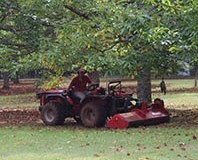Read the latest information on
Foot-and-mouth disease

Mulching fallen leaves and fruit can turn a biosecurity risk into a valuable source of nutrients
Using good on farm hygiene reduces the risk of spreading pests and diseases and minimises the risks they pose to your business.
For chestnut and walnut producer Alison Saunders, that means using simple hygiene practices for product harvesting, sorting, packaging and storage activities, and disposal of waste materials. It also means managing plant propagation and supply activities on farm.
Alison has found that biosecurity practices can often overlap with good management practice more generally. This means that biosecurity is part of what happens on the farm every day.
This applies at all times of the year, but particularly so during harvest.
Soil and plant material adhering to harvested crops can carry insect pests and disease organisms into the sorting and packing sheds. There’s a focus on keeping pests and diseases out of the packing operations and cold store.
“Whilst we try to minimise bringing any foreign or diseased materials into the packing shed, we do check all the nuts again over the bench, removing any unwanted material. All of our staff are made aware of what to look out for,” said Alison.
“Once all of the waste material is collected, it is removed right away from our production and packing areas and is buried.”
Leaf material or fallen fruit and nuts can attract or harbour pests and diseases, so it’s important to break the pest lifecycle. Alison’s tactic is to turn leaf litter and chestnut burrs back into a resource, while minimising the disease risk.
“In the orchard at the end of harvest we mulch our leaf litter and plant waste back into the soil. This is good for recycling important nutrients, but at the same time it helps with biosecurity by removing potential sites where pests and diseases can develop.”
At other times of the year, an important biosecurity consideration in the industry is the risk associated with sharing propagation material between farms.
“Because we are particularly conscious of this issue we strictly source all of our propagation material on farm so we don’t risk receiving diseases in this way,” said Alison.
“We know the growing history and genetic background of the seedlings and rootstock used for grafting and are confident of the disease status of our nursery stock. We don’t want to pass disease on to other properties.”
“For us, good biosecurity makes good business sense.”